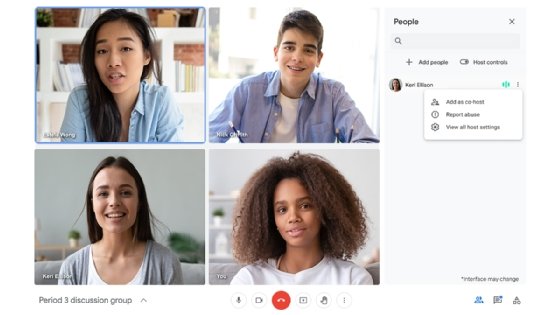
osorioartist - Fotolia
Google overhauls education suite, adding 50-plus features
Google has changed G Suite for Education into Workspace for Education, adding features to its Classroom and Meet apps to help educators with classroom management.
Google has announced plans to overhaul G Suite for Education, its online education suite. The changes will include rebranding it as Google Workspace for Education and adding a slew of features to its learning management system Classroom and video conferencing app Meet.
Google introduced the changes this week, a few months after renovating the productivity platform G Suite. Google said it will release more than 50 education features throughout the year. They include the ability to mute all participants on a Meet call, import grades and rosters into Classroom and see data collected through Classroom and Meet.
Zeus Kerravala, principal analyst at ZK Research, said the updates hit many important education areas by letting teachers monitor engagement and offering more remote classroom analytics.
"What we were doing before for education is just using off-the-shelf collaboration tools and making it fit into education," Kerravala said. "But education is a very unique vertical."
Changes to Classroom
Many of the new features Google announced will appear in Classroom later this year.
One new feature will let teachers populate and sync class rosters directly to Classroom from their Student Information System. The data store holds grades, rosters, registration, demographics and other important student information.
"The integration allows Google Classroom to talk to the student system, [which is] not necessary at a small school but essential at larger schools," said Laura Gogia, research director at higher education research firm The Tambellini Group.
Google will also launch a student engagement tracking feature that will show teachers who submitted assignments, commented on posts or otherwise interacted in Classroom.
Some new Classroom features will allow for more accessibility. Students will soon be able to open, write and review assignments on the Classroom Android app. A rich text formatting upgrade will let teachers and students bold, italicize, underline and bullet point posts. This will make it easier to "draw attention to keywords," said Karyn Fillhart, technology training specialist for the Chino Valley Unified School District.
To help detect plagiarism, Google will expand its originality reports to 15 languages. They include English, Spanish, French, German, Portuguese, Italian, Danish, Norwegian, Finnish, Swedish, Indonesian, Japanese, Korean, Malay and Hindi.
Changes to Meet
Google Meet will also get a bunch of new education functions this year.
A feature coming in the next few months lets meeting hosts mute everyone at once during a video conference. The feature will help hosts prevent disruptions from participants, Google said in a blog post.
Teachers will be able to end meetings for all participants, and students will not be able to join meetings before the teacher. According to Fillhart, it is a critical feature set because students were left unsupervised before.
"Unsupervised students can be an issue," Fillhart said. "There might be inappropriate screen sharing, video feeds, language [and bullying], which concerned teachers and administrators."
Another Meet feature will allow all teachers to be hosts by default, meaning multiple teachers can facilitate a single class session. Before, there could only be one host in a meeting.
"Some teachers have had their administrators or special education staff join their Meets," Fillhart said. "Unfortunately, sometimes that other person has had the host controls instead of the teacher. So, we are looking forward to co-moderators."

Accessibility features are coming to Meet, too. Google said it would improve the way Meet works on low bandwidth, so students with weaker internet connections can participate in classes. Google has optimized Meet for more reliable audio and video performance on its thin client laptop Chromebook. Forty new models are coming out this year.
"Bandwidth requirements were always a problem for Google Meet, so the reduced requirements and improved performance on Chromebook will be a relief for many instructors," Gogia said
Google also touted the ability for students to react in meetings with emojis. Kerravala said the feature is a good start. However, he was surprised that Google had not taken advantage of its AI capabilities to add physical gesture reactions like Cisco recently did in Webex.
"I would like to see Google build some more AI features," Kerravala said of the education suite.
Other Workspace for Education changes
The Education suite's pricing packages and storage policies will change as part of the overhaul.
As of this week, there are three pricing tiers for the suite: Google Workspace for Education Fundamentals, which is free; Google Workspace for Education Standard, which builds on Fundamentals and offers more visibility tools and advanced audit logs; Teaching and Learning Upgrade, which builds on Standard or Fundamentals and adds new video features in Meet; and Google Workspace for Education Plus, which includes all of the available education features.
Google used to offer unlimited storage to qualifying schools and universities. Going forward, the company said it will change its storage apportionment in response to the growth in storage consumption and ensure "fair distribution" of storage across all institutions.
The new storage model will allow for 100 TB of storage across all users within an institution. Google said that's enough for more than 100 million documents, 8 million presentations or 400,000 hours of video. The policy will go into effect in July 2022. Teaching and Learning Upgrade and Education Plus customers will get more storage.
Education market
Gogia said Google has fallen behind its competitors in the US market from a higher education perspective over the past year. Its platform required greater bandwidth than competitors, it had more connectivity issues, and it involved more workarounds for education extensions.
Gogia added that the new Meet features are playing catch-up to offerings from Microsoft and Zoom.
"Of the market leaders in the U.S., Google was the slowest to roll out enhancements," Gogia said. "It was considered an economical but less popular option [for higher education]."







